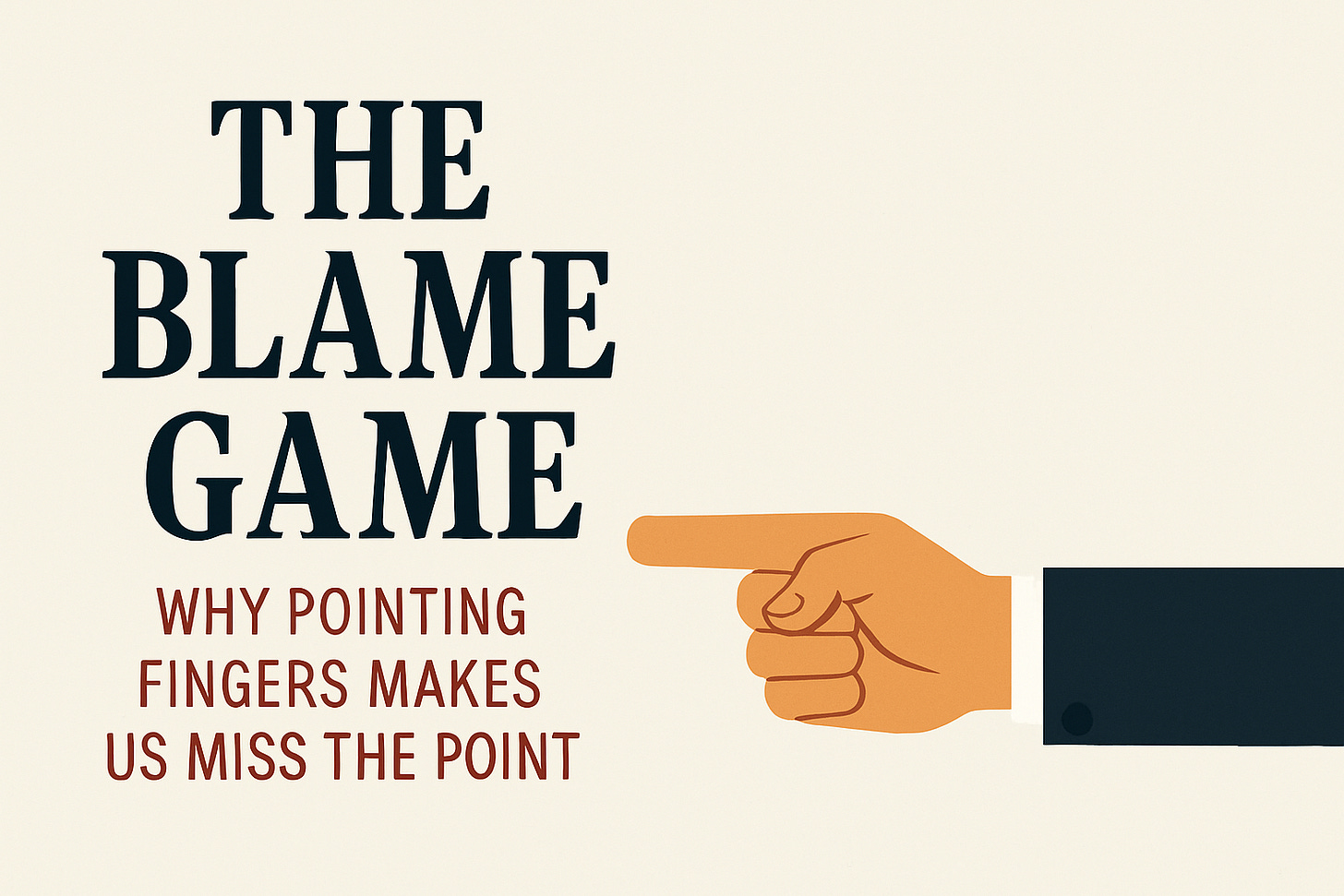The Blame Game: Why Pointing Fingers Makes Us Miss the Point
How the Blame Instinct clouds our judgment, stifles progress—and what to do instead
Have you ever felt a surge of satisfaction in finding someone to blame when things go wrong? A co-worker misses a deadline, a politician makes a bad call, or a customer lashes out—and your brain races to assign fault.
That’s not just emotion. It’s what Hans Rosling calls the Blame Instinct: our deep-seated tendency to identify a culprit when faced with problems, even when reality is far more complex. This instinct may feel intuitive, but it can lead to poor decisions, broken relationships, and systemic failures.
Let’s unpack how the Blame Instinct works, why it’s so seductive, and what we can do to rise above it.
Understanding the Blame Instinct
The Blame Instinct operates like this:
Something bad happens.
We feel discomfort or confusion.
Instead of analyzing the situation, our mind jumps to “Who is at fault?”
Blame offers a quick emotional release. It creates the illusion of control by giving us someone to hold responsible. But like many cognitive shortcuts, it’s a trap.
Example:
After a plane crash, media outlets often spotlight a single pilot error. However, aviation experts know that crashes are rarely due to just one mistake—they’re usually a chain of failures, including communication issues, mechanical faults, training gaps, and poor weather conditions. Focusing only on the pilot misses critical insights that could prevent future disasters.
Real-World Examples of the Blame Instinct
1. Workplace Conflicts
A team misses its quarterly goals. The manager blames the sales director. However, upon closer inspection, marketing failed to deliver leads, operations were understaffed, and the product team overlooked key features. A culture of blame stifles honest reflection, and repeated failure becomes more likely.
2. Politics and Public Policy
Voters often blame a sitting president for rising gas prices, even though global markets, supply chains, wars, and natural disasters influence prices. Politicians lean into this instinct to gain support (“It’s their fault!”), while distracting from real causes or solutions.
3. Healthcare
In hospitals, if a patient is harmed, there’s a rush to blame the nurse or doctor. However, in many cases, the issue is systemic, stemming from staff shortages, miscommunication, or broken processes. The healthcare industry has begun shifting toward “systems thinking,” recognizing that focusing solely on individuals hinders progress.
The Cost of the Blame Instinct
Blame isn’t just unproductive—it’s destructive.
It erodes trust. When people feel scapegoated, they become defensive or disengaged.
It reduces learning. If we blame rather than investigate, we miss key lessons.
It stifles innovation. In blame-heavy environments, people are often hesitant to take risks or admit mistakes.
Case in Point:
The 1986 Challenger disaster was traced back to faulty O-ring seals. Engineers had raised concerns, but NASA’s culture made it hard to challenge decisions. No one wanted to be the one to “blame.” The result? Catastrophe.
Section 4: How to Counter the Blame Instinct
Here are seven practical strategies to break free from the Blame Instinct and build a more thoughtful, constructive mindset:
1. Ask “What” Instead of “Who”
Shift your reflex from “Who messed this up?” to “What went wrong?” This leads to root cause thinking.
Instead of: “Who dropped the ball?”
Try: “What process failed—and how can we improve it?”
2. Practice Systems Thinking
Rarely does one factor cause failure. Take a step back and look at the bigger picture.
Use tools like fishbone diagrams or “5 Whys” to unpack causes beneath the surface.
3. Delay Judgment
Give yourself time before concluding. Most snap judgments are shaped by emotion rather than logic.
Tip: Sleep on major decisions involving fault or conflict. You’ll often see more nuance in the morning.
4. Create Psychological Safety
In team settings, encourage candor over cover-ups. When people feel safe admitting mistakes, blame gives way to learning.
Reference: Google’s Project Aristotle found that psychological safety was the most important factor in team effectiveness.
5. Look for Repeating Patterns
If the same type of failure occurs repeatedly, blaming individuals is almost certainly missing the point.
Repetition = systemic issue.
6. Use Neutral Language
Avoid loaded terms like “fault,” “screw-up,” or “guilty.” Use descriptive, not judgmental, language.
Instead of: “Whose fault is this?”
Try: “How did this outcome happen?”
7. Reward Problem-Solving, Not Finger-Pointing
Publicly recognize people who fix things, not just those who identify who’s to blame.
This creates a culture of accountability without shame.
From Blame to Better Outcomes
Blame is a mental reflex. It’s fast, satisfying, and wrong more often than it’s right. The Blame Instinct may feel natural, but when we lean into it, we sacrifice understanding and growth.
Instead, what if we got curious instead of angry? What if we asked more questions, sought systemic patterns, and built cultures where learning matters more than punishment?
You’ll find that moving past blame doesn’t just improve your problem-solving. It strengthens your leadership, relationships, and self-awareness.
So next time something goes wrong, pause. Breathe. Ask better questions.
And remember: finding fault is easy. Fixing systems is progress.
Maybe for you it’s about always being right, but that might be a story you’re telling yourself.


